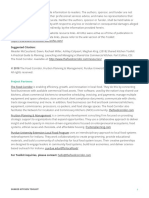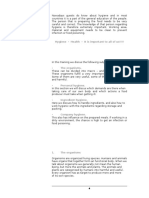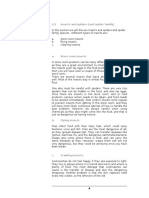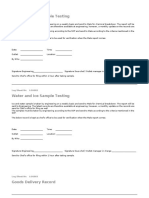0 ratings0% found this document useful (0 votes)
15 viewsTemporry Pottu
Temporry Pottu
Uploaded by
mohamed.mauroofThe document discusses bacteria multiplication rates at different temperatures. It notes that bacteria multiply very fast at temperatures between 30-37 degrees C, taking only 20 minutes for each generation, resulting in over 16 million bacteria after 8 hours. In contrast, at 7 degrees C bacteria take an hour for each generation, leading to only 256 bacteria after 8 hours. It emphasizes the importance of keeping food cold to slow bacteria multiplication.
Copyright:
© All Rights Reserved
Available Formats
Download as PDF, TXT or read online from Scribd
Temporry Pottu
Temporry Pottu
Uploaded by
mohamed.mauroof0 ratings0% found this document useful (0 votes)
15 views1 pageThe document discusses bacteria multiplication rates at different temperatures. It notes that bacteria multiply very fast at temperatures between 30-37 degrees C, taking only 20 minutes for each generation, resulting in over 16 million bacteria after 8 hours. In contrast, at 7 degrees C bacteria take an hour for each generation, leading to only 256 bacteria after 8 hours. It emphasizes the importance of keeping food cold to slow bacteria multiplication.
Original Title
temporry pottu
Copyright
© © All Rights Reserved
Available Formats
PDF, TXT or read online from Scribd
Share this document
Did you find this document useful?
Is this content inappropriate?
The document discusses bacteria multiplication rates at different temperatures. It notes that bacteria multiply very fast at temperatures between 30-37 degrees C, taking only 20 minutes for each generation, resulting in over 16 million bacteria after 8 hours. In contrast, at 7 degrees C bacteria take an hour for each generation, leading to only 256 bacteria after 8 hours. It emphasizes the importance of keeping food cold to slow bacteria multiplication.
Copyright:
© All Rights Reserved
Available Formats
Download as PDF, TXT or read online from Scribd
Download as pdf or txt
0 ratings0% found this document useful (0 votes)
15 views1 pageTemporry Pottu
Temporry Pottu
Uploaded by
mohamed.mauroofThe document discusses bacteria multiplication rates at different temperatures. It notes that bacteria multiply very fast at temperatures between 30-37 degrees C, taking only 20 minutes for each generation, resulting in over 16 million bacteria after 8 hours. In contrast, at 7 degrees C bacteria take an hour for each generation, leading to only 256 bacteria after 8 hours. It emphasizes the importance of keeping food cold to slow bacteria multiplication.
Copyright:
© All Rights Reserved
Available Formats
Download as PDF, TXT or read online from Scribd
Download as pdf or txt
You are on page 1of 1
80
60
40
20
Bacteria Bacteria Bacteria
multiply multiply multiply
very fast slowly
Note: Bacteria do not multiply when frozen, but also do not
die.
Time
Micro organisms need time to multiply themselves. At the
temperature of 30 to 37 gr. C , the growth is at its best. To
multiply them selves they need for each time only 20
minutes, which in case of one bacteria, you will have
16,000,000 bacteria after 8 hours. This amount is more than
sufficient to make people ill. If the temperature is lower for
example 7 gr. C, than it takes only one hour to multiply. So
after 8 hours
there will only be 256 bacteria. That is the difference when
keeping food cold or warm. Keep therefore always your
products cold!!!
A bacteria multiply itself by splitting itself into two cells. (in
20 minutes)
20 Minutes
40 Minutes
60 Minutes
Multiply by Cell Splitting
Acid levels (pH)
The scale of acid level is worldwide acknowledged in pH. A
neutral product has a pH level of 7. This means it is not sour,
and not bitter. If a product is sour, the level will be below 7,
like 5 (medium sour). The best level micro organisms can
grow is between 6-8 gr. pH.
15
You might also like
- QualityLiposomalC InstructionsDocument5 pagesQualityLiposomalC InstructionsAZGG75286No ratings yet
- Humidity / Water: Temperature Scale For BacteriaDocument1 pageHumidity / Water: Temperature Scale For Bacteriamohamed.mauroofNo ratings yet
- Intro Food Micro 2Document16 pagesIntro Food Micro 2Samman zakaNo ratings yet
- Food PoisoningDocument6 pagesFood Poisoningdreamtrue4No ratings yet
- Kitsada Capstone Project 2022Document35 pagesKitsada Capstone Project 2022api-442877008No ratings yet
- Hurdle TechnologyDocument21 pagesHurdle TechnologyPallaviNo ratings yet
- Food Spoilage MicroorganismsDocument30 pagesFood Spoilage Microorganismsladyatiey100% (1)
- Microbiological Media Preparation: Broth AgarDocument4 pagesMicrobiological Media Preparation: Broth AgarJahseen Mae PabalinasNo ratings yet
- Stew BorwnDocument1 pageStew Borwnmohamed.mauroofNo ratings yet
- 01 Media PreparationDocument3 pages01 Media Preparationrohitmaurya2032002No ratings yet
- MCB180 EX13 Full ReportDocument3 pagesMCB180 EX13 Full ReportMyles ResumaNo ratings yet
- GRADE.7 Microorganisms HWDocument1 pageGRADE.7 Microorganisms HWFaiza FauziNo ratings yet
- Microbial GrowthDocument95 pagesMicrobial GrowthIthnan PutraNo ratings yet
- Lesson 04 Growing Bacteria in A Lab - Experiments & ConditionsDocument4 pagesLesson 04 Growing Bacteria in A Lab - Experiments & ConditionsGwendolyn CalatravaNo ratings yet
- Fungal AmylaseDocument8 pagesFungal AmylaseangelinaanavarroNo ratings yet
- XDEZJ FritzZyme7Document1 pageXDEZJ FritzZyme7Hon TuNo ratings yet
- LaprakladyDocument16 pagesLaprakladyladyNo ratings yet
- IV. CEMARAN MIKROBA-kuliah-Toxicology-14 Juni 2019Document39 pagesIV. CEMARAN MIKROBA-kuliah-Toxicology-14 Juni 2019tiniNo ratings yet
- Developing Skills - Transcript + AnswersDocument1 pageDeveloping Skills - Transcript + Answersliem.nguyenthanh150305No ratings yet
- LAB 1 Safety and Microscope 1st 2021-2022Document42 pagesLAB 1 Safety and Microscope 1st 2021-2022Deena Hajj QasemNo ratings yet
- If You Don't Have An AutoclaveDocument1 pageIf You Don't Have An AutoclavebanzaiNo ratings yet
- The Good Bacteria: GI Jake - A Bifidobacterium!Document7 pagesThe Good Bacteria: GI Jake - A Bifidobacterium!Nurhanis Raof AnsarullahNo ratings yet
- Vitamina C LipozomalaDocument4 pagesVitamina C LipozomalaBacean Aurel IoanNo ratings yet
- Food SafetyDocument12 pagesFood Safetysherylmatchado07No ratings yet
- Theme: Health - (Reading Comprehension) Topic: Coronavirus (Covid-19)Document4 pagesTheme: Health - (Reading Comprehension) Topic: Coronavirus (Covid-19)Siti Aishah ZolkanainNo ratings yet
- Merx - A3-Living Conditions M (1) .O.Document5 pagesMerx - A3-Living Conditions M (1) .O.Alexe CristinelNo ratings yet
- Introduction To Food Microbiology ADocument66 pagesIntroduction To Food Microbiology AoreaNo ratings yet
- Hygienia EnglishDocument40 pagesHygienia EnglishAsanga MalNo ratings yet
- Presentation (1) 2Document17 pagesPresentation (1) 2Priya BhirmanNo ratings yet
- Biology Formative Del 1Document1 pageBiology Formative Del 1manuela cruzNo ratings yet
- Kuliah Ke II - Kontrol Mikrobia Dalam Bahan Produk Pangan Olahan (Temperatur Rendah) 2016Document29 pagesKuliah Ke II - Kontrol Mikrobia Dalam Bahan Produk Pangan Olahan (Temperatur Rendah) 2016Ichlasia Ainul FitriNo ratings yet
- Batch 11 BicmDocument15 pagesBatch 11 Bicmnikhil endraNo ratings yet
- Food Spoilage HandoutsDocument18 pagesFood Spoilage HandoutsNancy RagpotNo ratings yet
- Factors Affecting Microbial Growth - PP PresentationDocument37 pagesFactors Affecting Microbial Growth - PP PresentationCk_psihNo ratings yet
- Sampling Producer MilkDocument47 pagesSampling Producer MilkFadhilla SetyaNo ratings yet
- Why Is It Dangerous To Eat Meat Which Has Been Left Out and Then Cooked?Document5 pagesWhy Is It Dangerous To Eat Meat Which Has Been Left Out and Then Cooked?Shuhaib MDNo ratings yet
- Microbes in Human WelfareDocument21 pagesMicrobes in Human Welfarefhana4609No ratings yet
- Essential Food Safety TrainingDocument26 pagesEssential Food Safety TrainingMohamed azarudeenNo ratings yet
- 2060 en 1Document2 pages2060 en 1jjimenezveNo ratings yet
- Guidelines For Slaughtering, Meat Cutting and Further ProcessingDocument113 pagesGuidelines For Slaughtering, Meat Cutting and Further ProcessingJulius MuhimboNo ratings yet
- Different Groups of Microbes Present in FoodDocument5 pagesDifferent Groups of Microbes Present in FoodKANHAIYA BHANUSHALINo ratings yet
- All About Germs LabDocument3 pagesAll About Germs Labjsmorgan2012No ratings yet
- Media PreparationDocument4 pagesMedia PreparationJohn Andrew PanizalesNo ratings yet
- Science Invest 2Document7 pagesScience Invest 2owmnerdzNo ratings yet
- Bacteriological Examinations of StoolDocument5 pagesBacteriological Examinations of StoolPhiliplukaNo ratings yet
- Typical Uses of Hydrogen PeroxideDocument48 pagesTypical Uses of Hydrogen PeroxideFatManWalkin100% (1)
- How to Make Okara Tempeh: Detailed instructions & Troubleshooting - Easy, Home-made, Delicious!From EverandHow to Make Okara Tempeh: Detailed instructions & Troubleshooting - Easy, Home-made, Delicious!Rating: 5 out of 5 stars5/5 (1)
- Bacterial Growth Curve: 1. Lag PhaseDocument3 pagesBacterial Growth Curve: 1. Lag PhaseRyan OdioNo ratings yet
- Replication and GrowthDocument21 pagesReplication and GrowthShafici CqadirNo ratings yet
- Spawn Production Technology (Seed For Mushroom)Document32 pagesSpawn Production Technology (Seed For Mushroom)Shivendra SinghNo ratings yet
- Food Microbiology SlidesDocument65 pagesFood Microbiology SlidesRoshini KuppiliNo ratings yet
- Unit 2 Techniques in Controlling Pathogenic MicroorganismsDocument8 pagesUnit 2 Techniques in Controlling Pathogenic Microorganisms2023800041No ratings yet
- Relationship Microorganism-Sanitation - 5Document15 pagesRelationship Microorganism-Sanitation - 5gusty8primandaNo ratings yet
- AY 2020/2021 1.1 - Lab 1: Isolations Page 1Document18 pagesAY 2020/2021 1.1 - Lab 1: Isolations Page 1Mike TNo ratings yet
- Microbes NotesDocument22 pagesMicrobes Notesapi-218511741100% (1)
- E1procedures Software House: Haccp Food HygieneDocument60 pagesE1procedures Software House: Haccp Food HygieneTan Tok Hoi100% (1)
- BacteriaDocument2 pagesBacteriaapi-298865320No ratings yet
- Gut Bugs, Dust Mites, and Other Microorganisms You Can't Live WithoutFrom EverandGut Bugs, Dust Mites, and Other Microorganisms You Can't Live WithoutNo ratings yet
- Microbe Adaptations: Glowing Lights, Hot Vents, and Large NumbersFrom EverandMicrobe Adaptations: Glowing Lights, Hot Vents, and Large NumbersNo ratings yet
- Fire HeartDocument1 pageFire Heartmohamed.mauroofNo ratings yet
- Rachael Miller Ashley Colpaart Meghan King Dawn Meader MccauslandDocument1 pageRachael Miller Ashley Colpaart Meghan King Dawn Meader Mccauslandmohamed.mauroofNo ratings yet
- Soaking Time PDFDocument1 pageSoaking Time PDFmohamed.mauroofNo ratings yet
- Oike MasterDocument1 pageOike Mastermohamed.mauroofNo ratings yet
- Polop PDFDocument1 pagePolop PDFmohamed.mauroofNo ratings yet
- Quest Mike PDFDocument1 pageQuest Mike PDFmohamed.mauroofNo ratings yet
- Dig DeeperDocument1 pageDig Deepermohamed.mauroofNo ratings yet
- 4.1 Maintenance of The Body The SkinDocument1 page4.1 Maintenance of The Body The Skinmohamed.mauroofNo ratings yet
- Trust OnnoDocument1 pageTrust Onnomohamed.mauroofNo ratings yet
- Blank FigDocument1 pageBlank Figmohamed.mauroofNo ratings yet
- Bacteria That Causes Food SpoilageDocument1 pageBacteria That Causes Food Spoilagemohamed.mauroofNo ratings yet
- Table TopsDocument1 pageTable Topsmohamed.mauroofNo ratings yet
- The Sensitive Skin of The HandsDocument1 pageThe Sensitive Skin of The Handsmohamed.mauroofNo ratings yet
- Hay TimeDocument1 pageHay Timemohamed.mauroofNo ratings yet
- Stew BorwnDocument1 pageStew Borwnmohamed.mauroofNo ratings yet
- PH Scale, From 0 To 14: OxygenDocument1 pagePH Scale, From 0 To 14: Oxygenmohamed.mauroofNo ratings yet
- Hygiene - Health - It Is Important To All of Us!!!!Document1 pageHygiene - Health - It Is Important To All of Us!!!!mohamed.mauroofNo ratings yet
- Prevention of Macro OrganismsDocument1 pagePrevention of Macro Organismsmohamed.mauroofNo ratings yet
- Wire SeamDocument1 pageWire Seammohamed.mauroofNo ratings yet
- MacronnDocument1 pageMacronnmohamed.mauroofNo ratings yet
- Done TrackDocument1 pageDone Trackmohamed.mauroofNo ratings yet
- 2.2 Insects and Spiders (And Spider Family)Document1 page2.2 Insects and Spiders (And Spider Family)mohamed.mauroofNo ratings yet
- Intro: "Health Is The Condition of Completely Physical, Mental and Social Well Being Without Illness or Weakness"Document1 pageIntro: "Health Is The Condition of Completely Physical, Mental and Social Well Being Without Illness or Weakness"mohamed.mauroofNo ratings yet
- C. Decease Causing Micro OrganismsDocument1 pageC. Decease Causing Micro Organismsmohamed.mauroofNo ratings yet
- At The Receiving AreaDocument1 pageAt The Receiving Areamohamed.mauroofNo ratings yet
- Refrigerators, PDFDocument1 pageRefrigerators, PDFmohamed.mauroofNo ratings yet
- From The Receiver, The Assigned PDFDocument1 pageFrom The Receiver, The Assigned PDFmohamed.mauroofNo ratings yet
- Water and Ice Sample Testing: Log Sheet NR: LOG002Document1 pageWater and Ice Sample Testing: Log Sheet NR: LOG002mohamed.mauroofNo ratings yet
- Product Temperatu Re Condition Comments: Log Sheet NR: LOG004Document1 pageProduct Temperatu Re Condition Comments: Log Sheet NR: LOG004mohamed.mauroofNo ratings yet























































































